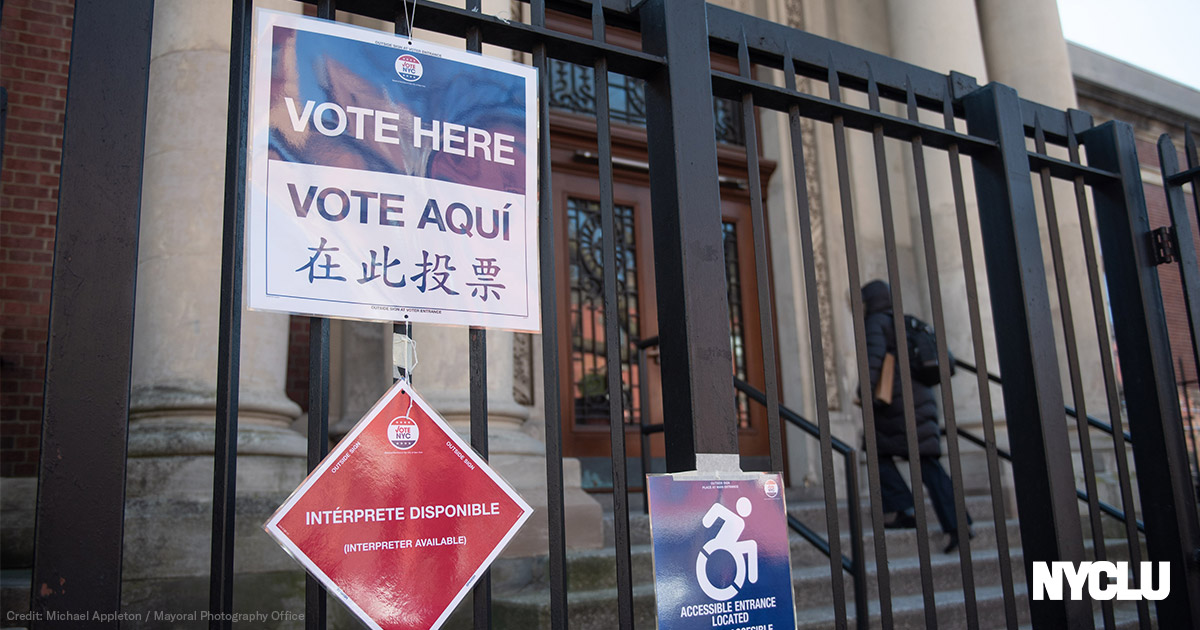Column: Constitutional Limits on Congressional Investigations Into Palestine-Israel Advocacy
Civil Liberties Union

The battle over whether New York should hold a Democratic presidential primary has grabbed the media spotlight.
But the focus on this intraparty fight obscures a broader issue that the state must grapple with immediately: In the midst of the coronavirus pandemic, can New York transform from a state with one of the lowest rates of absentee voting into one in which most people vote by mail? And can it do so before the elections, which are fast approaching on June 23?
The Democratic primary controversy started when lawmakers inserted a provision into this year’s state budget that allowed New York’s Board of Elections to remove any presidential primary candidate who has suspended their campaign. The BOE later voted to do just that, effectively canceling the state’s primary elections.
That move prompted a lawsuit from Democratic Primary candidate Andrew Yang, and a subsequent decision earlier this month from a federal judge reinstating the primary. The BOE appealed the ruling, but a circuit court affirmed the judge’s decision.
The primary will indeed take place in June.
New York is at the center of the coronavirus pandemic. Holding the presidential primary election in all or part of 27 counties that would otherwise have no elections in June could put the health of nearly 1.5 million eligible voters and 4,600 poll workers at risk in an election in which the outcome is already determined. Joe Biden is the only candidate who has not suspended his campaign and is still actively seeking the Democratic nomination for president.
But U.S. District Judge Analisa Torres sided with Yang and ruled that canceling the primary deprives candidates like Yang a chance to influence Democratic Party politics by amassing delegates to the party’s national convention and robs voters of their opportunity “to express their political views.”
While the Democratic primary garners most of the attention, it is the effort to secure robust absentee voting that will play a far bigger role in making sure New York’s elections are fair and safe.
The case for Yang is also bolstered by the fact that, pursuant to Gov. Cuomo’s Executive Order, any voter who wants to vote absentee may do so. New York is the only state in the country that has canceled its primary election — but it’s also fair to point out that the Republican Party canceled its presidential primary even before New York’s COVID PAUSE went into effect.
With the circuit court’s ruling ensuring the primary will move forward, a much bigger challenge looms. New York must quickly transition from a state in which more than 90 percent of voters cast ballots in-person, to one in which a huge percentage of people vote absentee.
Wisconsin offers a cautionary tale for what can happen when a state with a historically low number of absentee voters holds an election during the pandemic. Thousands of the state’s voters never got the absentee ballots they requested. Then a lack of poll workers prompted officials to shutter dozens of polling locations, which created long lines and dangerous conditions at the sites that did open.
Dozens of voters and poll workers later contracted the virus.
After prodding from the NYCLU and other voting rights organizations, New York has taken important steps to encourage robust enfranchisement.
Gov. Cuomo signed an executive order that allows anyone who doesn’t want to vote in-person because of COVID-19 to request an absentee ballot. And now both absentee ballot request forms and ballots themselves will come with postage-paid return envelopes. In addition, in-person voting will be available for those who can safely vote at poll sites or need assistance to vote.
Moving forward, the NYCLU is pushing for more critical reforms to make sure New Yorkers can vote absentee.
The state should require that ballots be accepted seven days after Election Day, regardless of when or if they are postmarked. Currently, New York law counts ballots received up to seven days after elections, but only if they are postmarked by the day before Election Day.
In Wisconsin, the massive increase in absentee ballot requests overwhelmed elections officials, and the backlogs resulted in many voters not receiving their absentee ballots until after Election Day. New York can help reduce the harm from any delays by honoring the existing state deadline for ballot acceptance even if postmarks are late or missing.
At a minimum, the state should extend the deadline for sending absentee ballots through Election Day. Under current law, absentee ballots must be postmarked by no later than the day before the elections. Without this reform, many people voting absentee for the first time will likely be unaware of the current deadline, and they could have their votes thrown out.
While the Democratic primary garners most of the attention, it is the effort to secure robust absentee voting that will play a far bigger role in making sure New York’s elections are fair and safe.